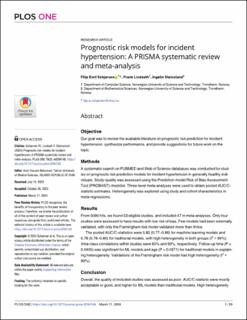| dc.contributor.author | Schjerven, Filip Emil | |
| dc.contributor.author | Lindseth, Frank | |
| dc.contributor.author | Steinsland, Ingelin | |
| dc.date.accessioned | 2024-03-14T10:52:03Z | |
| dc.date.available | 2024-03-14T10:52:03Z | |
| dc.date.created | 2024-03-13T08:22:59Z | |
| dc.date.issued | 2024 | |
| dc.identifier.issn | 1932-6203 | |
| dc.identifier.uri | https://hdl.handle.net/11250/3122387 | |
| dc.description.abstract | Objective
Our goal was to review the available literature on prognostic risk prediction for incident hypertension, synthesize performance, and provide suggestions for future work on the topic. | en_US |
| dc.description.abstract | Methods
A systematic search on PUBMED and Web of Science databases was conducted for studies on prognostic risk prediction models for incident hypertension in generally healthy individuals. Study-quality was assessed using the Prediction model Risk of Bias Assessment Tool (PROBAST) checklist. Three-level meta-analyses were used to obtain pooled AUC/C-statistic estimates. Heterogeneity was explored using study and cohort characteristics in meta-regressions. | en_US |
| dc.description.abstract | Results
From 5090 hits, we found 53 eligible studies, and included 47 in meta-analyses. Only four studies were assessed to have results with low risk of bias. Few models had been externally validated, with only the Framingham risk model validated more than thrice.
The pooled AUC/C-statistics were 0.82 (0.77–0.86) for machine learning models and 0.78 (0.76–0.80) for traditional models, with high heterogeneity in both groups (I2 > 99%). Intra-class correlations within studies were 60% and 90%, respectively. Follow-up time (P = 0.0405) was significant for ML models and age (P = 0.0271) for traditional models in explaining heterogeneity. Validations of the Framingham risk model had high heterogeneity (I2 > 99%). | en_US |
| dc.description.abstract | Conclusion
Overall, the quality of included studies was assessed as poor. AUC/C-statistic were mostly acceptable or good, and higher for ML models than traditional models. High heterogeneity implies large variability in the performance of new risk models. Further, large heterogeneity in validations of the Framingham risk model indicate variability in model performance on new populations.
To enable researchers to assess hypertension risk models, we encourage adherence to existing guidelines for reporting and developing risk models, specifically reporting appropriate performance measures. Further, we recommend a stronger focus on validation of models by considering reasonable baseline models and performing external validations of existing models. Hence, developed risk models must be made available for external researchers. | en_US |
| dc.language.iso | eng | en_US |
| dc.publisher | PLOS | en_US |
| dc.rights | Navngivelse 4.0 Internasjonal | * |
| dc.rights.uri | http://creativecommons.org/licenses/by/4.0/deed.no | * |
| dc.title | Prognostic risk models for incident hypertension: A PRISMA systematic review and meta-analysis | en_US |
| dc.title.alternative | Prognostic risk models for incident hypertension: A PRISMA systematic review and meta-analysis | en_US |
| dc.type | Journal article | en_US |
| dc.type | Peer reviewed | en_US |
| dc.description.version | publishedVersion | en_US |
| dc.source.journal | PLOS ONE | en_US |
| dc.identifier.doi | 10.1371/journal.pone.0294148 | |
| dc.identifier.cristin | 2253948 | |
| cristin.ispublished | true | |
| cristin.fulltext | original | |
| cristin.qualitycode | 1 | |

